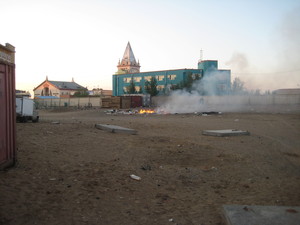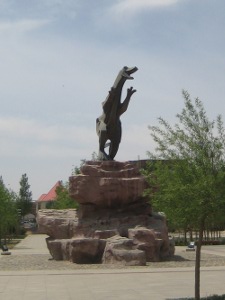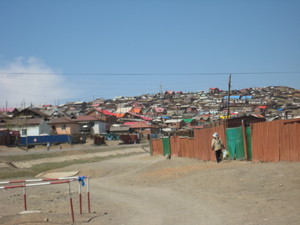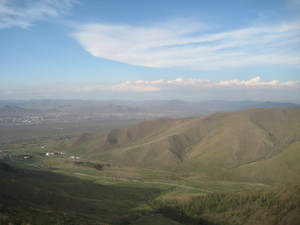Thursday, June 23. 2011
Trapped by tropical Typhoon
 Due to current events, I'm abandoning the chronological order of my trip reports. You have probably read about the floods currently in China.
Due to current events, I'm abandoning the chronological order of my trip reports. You have probably read about the floods currently in China.We are currently in Haikou on Hainan Island in the south of China. Our plan was to take the ferry to Guangzhou today but all ferry services are cancelled due to the Typhoon Haima. You can follow its way on this japanese webpage.
So we are trapped and our Hotel will have us as guests some days more.
Sidenote: I had hoped to get informed about such dangers by the travelling information from the foreign ministry of Germany. But it doesn't even mention the Typhoon and Flood at all. The UK information was a bit more helpful.
Update: We've long left the typhoon area and nothing happened to us, I just didn't have the time to complete further blog entries.
Monday, June 13. 2011
From Mongolia to China
 I promised before that I'll present a cheaper way than the international train to get from Ulaanbaatar on to China. But after doing it and all its obstacles, I'm not sure if I'd suggest it any more.
I promised before that I'll present a cheaper way than the international train to get from Ulaanbaatar on to China. But after doing it and all its obstacles, I'm not sure if I'd suggest it any more.Taking the normal train route on the transmongolian train, the way from Ulaanbaatar to any place in China is quite expensive. Our hostel offered us a train ticket to Jining (濟寧市) or Datong (大同市) for about 140 $. It would've probably been a bit cheaper at the train station, but still it's quite expensive.
Some people in the Hostel told us about a cheap alternative: Taking a local train to the border town Zamyn-Üüd (Замын-Үүд), then going with a Jeep through the border and then using a bus from Erenhot (二连浩特, also called Erlian) to Hohhot (呼和浩特, ᠬᠥᠬᠡᠬᠣᠲᠠ). However, it turned out that it wasn't that simple.
The ticket for the local train to the border costed 10.000 ₮ (about 7 €) for a hardsleeper. But it came with an unplesant surprise: They sell more "hardsleeper" tickets than there are hardsleepers in the train. So having a hardsleeper ticket with a reservation number does not mean that you have your sleeper for sure. For every two sleepers, three tickets are sold. We ended up having the lower beds and we could use them, but regularly people were sitting at the foot end of our sleepers.
 We wanted to go on from Zamyn-Üüd to Erenhot and were confronted with the next unplesant surprise: It was the first of June - international childrens day - and that's a national holiday in Mongolia and the border check is closed. So we were stuck in Zamyn-Üüd for a day longer.
We wanted to go on from Zamyn-Üüd to Erenhot and were confronted with the next unplesant surprise: It was the first of June - international childrens day - and that's a national holiday in Mongolia and the border check is closed. So we were stuck in Zamyn-Üüd for a day longer.In the evening, we saw the local way of "waste treatment": They just burned it openly. Mongolia is a country which has a lot of problems with air pollution (this is especially a problem of the capital city Ulaanbaatar, but I doubt it's much different there) - it would probably be easy to do this at least a bit better.
The next day, we went on with a jeep to the chinese border town Erenhot. In the end, we payed 10.000 ₮ (about 7 €) per Person plus a small fee at the chinese border I payed with a dollar due to the lack of any chinese or mongolian money.
There's not so much to say about Erenhot - the city is very fond of Dinosaurs (because some were found nearby in the Gobi desert) and has a couple of Dinosaur monuments.
 Now with that mysterious bus - I read on several places in the Internet that there exists a bus line between Erenhot and Hohhot, however none of them had anything to say where this bus departs, where you can buy a ticket or where you can find any information at all. It also turned out that communication here was a much bigger problem than thought - I think we didn't meet a single english-speaking person at all. So we ended up using a train to Hohhot, which was also quite cheap and comfortable.
Now with that mysterious bus - I read on several places in the Internet that there exists a bus line between Erenhot and Hohhot, however none of them had anything to say where this bus departs, where you can buy a ticket or where you can find any information at all. It also turned out that communication here was a much bigger problem than thought - I think we didn't meet a single english-speaking person at all. So we ended up using a train to Hohhot, which was also quite cheap and comfortable.We went to Hohhot not because of anything interesting there, it was just a stop to go on, as there aren't many options for further travelling from Erenhot. It turned out the People's Park there was quite nice and it was our first experience with a bigger chinese city. Afterwards, we went on to the south of China.
Pictures from Zamyn-Üüd
Pictures from Erenhot
Pictures from Hohhot
Tuesday, June 7. 2011
Ulaanbaatar
 The next stop on our trip was Ulaanbaatar (Улаанбаатар), the capital of Mongolia. Mongolia is the most sparsely populated country in the world and about one third of the population lives in Ulaanbaatar. Large parts of the city consist of ger districts - a ger is a typical mongolian nomadic tent. In those districts, people live very dense either in gers or in very simple wood houses.
The next stop on our trip was Ulaanbaatar (Улаанбаатар), the capital of Mongolia. Mongolia is the most sparsely populated country in the world and about one third of the population lives in Ulaanbaatar. Large parts of the city consist of ger districts - a ger is a typical mongolian nomadic tent. In those districts, people live very dense either in gers or in very simple wood houses.Ulaanbaatar is a growing city. The ger districts still grow and in the southern part, a lot of apartment buildings are built. I haven't checked this with other sources, but two people from Ulaanbaatar told me that these constructions are mostly illegal, because they are in a nature reservate where only tourist ger camps are allowed, but corruption allows the constructinos to happen anyway.
The car traffic is very extreme in Ulaanbaatar. Most of the time there's a lot of traffic jam. Many car drivers seem to think that tooting a lot helps in the traffic jam. Very dangerous driving habits are common (this was also the case in russia, but much less extreme).
 We wanted to visit the Terelj national park near Ulaanbaatar, but that failed because the bus times we got from the Internet were probably wrong (there is no bus at 11:00, no matter what the Internet tells you). Instead, we made a tour to the mountains south of the capital, which was also quite nice and interesting nature.
We wanted to visit the Terelj national park near Ulaanbaatar, but that failed because the bus times we got from the Internet were probably wrong (there is no bus at 11:00, no matter what the Internet tells you). Instead, we made a tour to the mountains south of the capital, which was also quite nice and interesting nature.We visited the Naran Tuul, which is a big market (REALLY big). You can get there just about anything, clothes, bicycles, food, solar cells, satellite dishes, ... We were warned a lot from pickpocketing in Ulaanbaatar in general and especially on the Naran Tuul, but we never had any problems with that.
One evening we visited the Tengis cinema, which I found a quite interesting experience. Movies there run in english with mongolian subtitles. The movie (Thor) was not so good (Pirates of the caribbean sadly wasn't running there yet). The cinema itself had much more atmosphere than the cinemas I'm used to from Germany. Below the cinema is an arcade - some crazy teenagers played a dance dance revolution-alike game in really unbelivable speed.
Pictures from Ulaanbaatar
Pictures from hills / nature near Ulaanbaatar
(Page 1 of 1, totaling 3 entries)